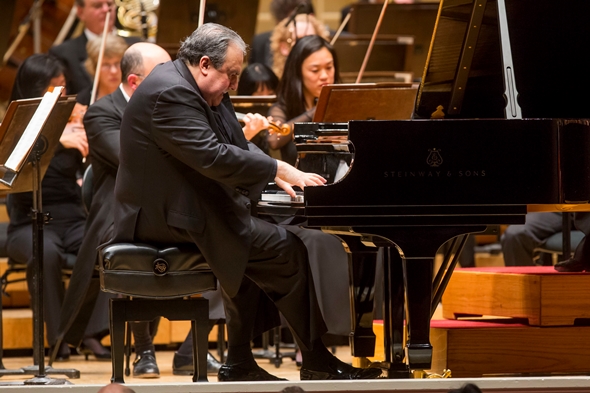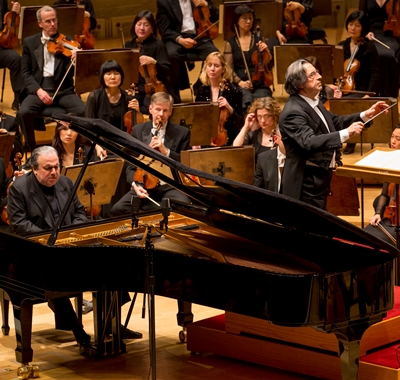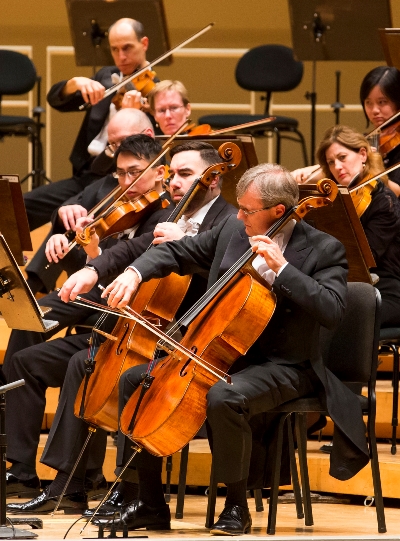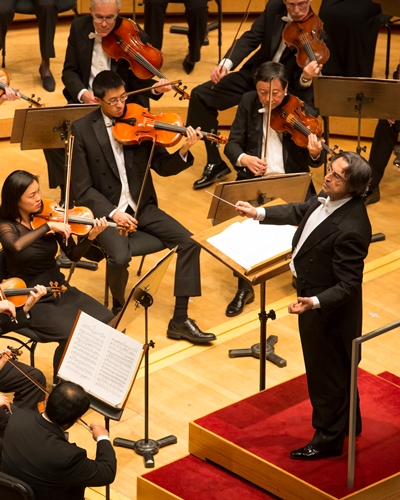Bronfman, Muti and CSO sketch chamber music on vast canvas of Brahms’ 2nd Piano Concerto
 Review: Chicago Symphony Orchestra; Riccardo Muti, conductor; Yefim Bronfman, piano. Through Jan. 17 at Orchestra Hall.
Review: Chicago Symphony Orchestra; Riccardo Muti, conductor; Yefim Bronfman, piano. Through Jan. 17 at Orchestra Hall.
By Lawrence B. Johnson
In broad, round terms, the figure of pianist Yefim Bronfman taking his seat at the keyboard to play Brahms’ Piano Concerto No. 2 in B-flat with the Chicago Symphony Orchestra and conductor Riccardo Muti on Jan. 15 immediately brought to mind images of the composer in exactly that posture. When Bronfman’s serene – really beyond sublime – performance had ended, that evocative association only felt confirmed.
 From the piano’s very first entry, ruminative and glistening, Bronfman’s traversal of Brahms’ heroically proportioned concerto was thrillingly un-heroic. No pouncing on the keys, no grandiloquently punctuated flourishes, no histrionics of any kind. It was playing so effortless, so contained yet musically specific, that it seemed almost casual – like catching Brahms in his studio, alone, musing over what he had written.
From the piano’s very first entry, ruminative and glistening, Bronfman’s traversal of Brahms’ heroically proportioned concerto was thrillingly un-heroic. No pouncing on the keys, no grandiloquently punctuated flourishes, no histrionics of any kind. It was playing so effortless, so contained yet musically specific, that it seemed almost casual – like catching Brahms in his studio, alone, musing over what he had written.
But of course Bronfman was not alone, not in any sense. Here, on this vast plain of musical invention and spiritual reflection, pianist and conductor and orchestra – every player to the last stand of the second fiddles – sang this soaring song as one, a huge chamber ensemble reveling in their outsized communion.
Indeed, despite its staggering scale, in the distribution and elaboration of ideas between piano and orchestra the Brahms’ Second Concerto is arguably the most balanced work of its kind. The celebrated Viennese critic Eduard Hanslick famously characterized it as “a symphony with piano obbligato,” and not only because of its imposing four-movement plan. The essential beauty of this performance lay in Muti’s hand-in-glove interaction with Bronfman, the sheer finesse of the CSO’s dialogue-like exchanges with the pianist and the soloist’s unfailingly poetic approach to an assignment of high virtuosic order.
At every point where another pianist might succumb to the lure of technical display – in the power-packed main theme of the first movement, the brilliant runs of the scherzo, the finale’s crowning majesty – Bronfman dialed back. Yet the piano’s voice never lost its presence or indeed its prominence; its star shone rather than glittered.
 Beyond the intimate connections between piano and orchestral voices – exquisite excursions with oboe, flute, bassoon, pairs of clarinets – the slow movement’s famous cello took arching wing on the bow of CSO principal cellist John Sharp, whose breathtaking interlude transported concerto and listener to another world, a celestial place bathed in pure radiance.
Beyond the intimate connections between piano and orchestral voices – exquisite excursions with oboe, flute, bassoon, pairs of clarinets – the slow movement’s famous cello took arching wing on the bow of CSO principal cellist John Sharp, whose breathtaking interlude transported concerto and listener to another world, a celestial place bathed in pure radiance.
When the CSO and Muti present three concerts at Carnegie Hall in New York at the end of January, Bronfman will repeat the Brahms Second. Happily, it will be paired with Schumann’s Symphony No. 3 in E-flat (“Rhenish”), which Muti and company recently played in Paris and Vienna to great effect.
Less happily on this occasion at Orchestra Hall, the concerto was mismatched with the 26-year-old Tchaikovsky’s Symphony No. 1 in G minor (“Winter Daydreams”). This season, Muti is conducting all the Tchaikovsky symphonies as well as other major works by the beloved Russian composer. In that spirit, the rather simple – one might even say inauspicious – First Symphony at least affords the appeal of a seldom-encountered curiosity. It doesn’t offer a lot more than that.
 While Tchaikovsky’s first venture into symphonic form already reveals his natural gift for melody, as well as a flair for waltzes and some musical figurations that would stamp his life’s work, it does not foretell the great composer to come. The symphony’s many appealing melodies are rivaled by vast planar surfaces that cry out for inflection. The scherzo’s vacuity leaves one convinced that a complete set of orchestral parts must be missing – the ones that provide the counterpoint. And the finale’s pounding peroration is almost amusing in its unwillingness to give up.
While Tchaikovsky’s first venture into symphonic form already reveals his natural gift for melody, as well as a flair for waltzes and some musical figurations that would stamp his life’s work, it does not foretell the great composer to come. The symphony’s many appealing melodies are rivaled by vast planar surfaces that cry out for inflection. The scherzo’s vacuity leaves one convinced that a complete set of orchestral parts must be missing – the ones that provide the counterpoint. And the finale’s pounding peroration is almost amusing in its unwillingness to give up.
Still, Muti clearly believes in the core worth of this Tchaikovsky symphony among the rest, and he assuredly coaxed the maximum charm from its best patches. The orchestra likewise gave its serious best in performance marked by warmth, precision and grace.
Related Link:
- Performance locations, dates and times: Details at CSO.org
Tags: Chicago Symphony Orchestra, Riccardo Muti, Yefim Bronfman

